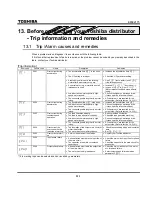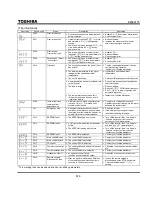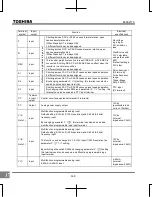
E6582175
N-3
14
Check items
1. Check to see if all screwed terminals are tightened firmly. If any screw is found loose, tighten it again
with a screwdriver.
2. Check to see if all caulked terminals are fixed properly. Check them visually to see that there is no trace
of overheating around any of them.
3. Check all cables and wires for damage. Check them visually.
4. Remove dirt and dust. With a vacuum cleaner, remove dirt and dust. When cleaning, clean the vents
and the printed circuit boards. Always keep them clean to prevent an accident due to dirt or dust.
5. If no power is supplied to the inverter for a long time, the performance of its large-capacity electrolytic
capacitor declines.
When leaving the inverter unused for a long time, supply it with electricity once every two years, for 5
hours or more each, to recover the performance of the large-capacity electrolytic capacitor. And also
check the function of the inverter. It is advisable not to supply the commercial power directly to the
inverter but to gradually increase the power supply voltage with a transformer, etc.
6. If the need arises, conduct an insulation resistance test on the main circuit terminal block only, using a
500V insulation resistance tester. Never conduct an insulation resistance test on control terminals other
than terminals on the printed circuit board or on control terminals. When testing the motor for insulation
resistance, separate it from the inverter in advance by disconnecting the cables from the inverter output
terminals U/T1, V/T2 and W/T3. When conducting an insulation resistance test on peripheral circuits
other than the motor circuit, disconnect all cables from the inverter so that no voltage is applied to the
inverter during the test.
Standard: Several M
Ω
or more. (Built-in noise filter cause to detect low insulation resistance.)
(Note) Before an insulation resistance test, always disconnect all cables from the main circuit terminal block
and test the inverter separately from other equipment.
500V
(megger)
R/L 1
S/L 2
T/L 3
U/T 1
V/T 2
W/T 3
7. Never test the inverter for dielectric strength. A dielectric test may cause damage to its components.
8. Voltage and temperature check
Recommended voltmeter : Input side ... Moving-iron type voltmeter (
)
Output side ... Rectifier type voltmeter (
)
It will be very helpful for detecting a defect if you always measure and record the ambient temperature
before, during and after the operation.
Содержание TOSVERT VF-S15 series
Страница 394: ......
















































